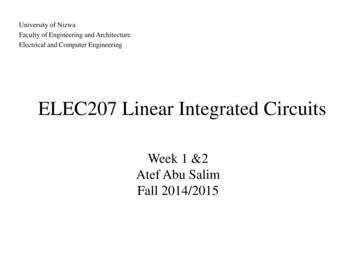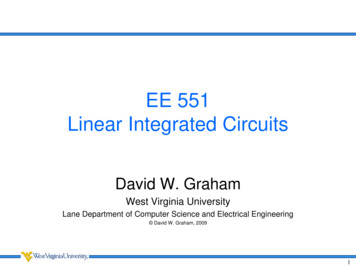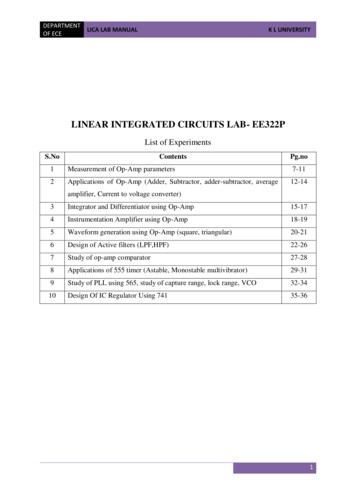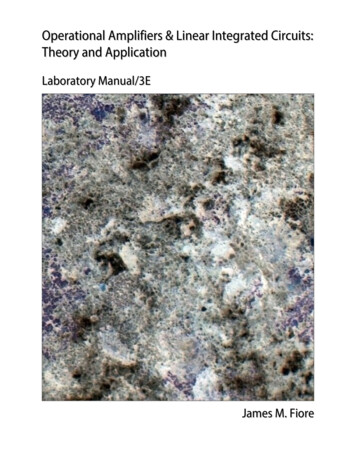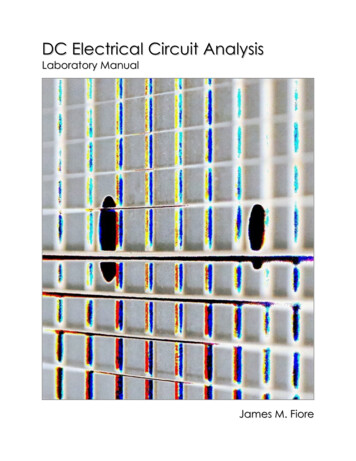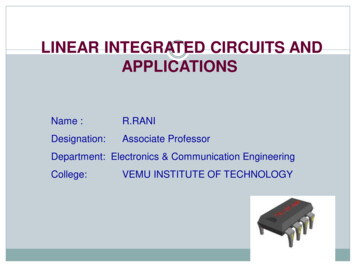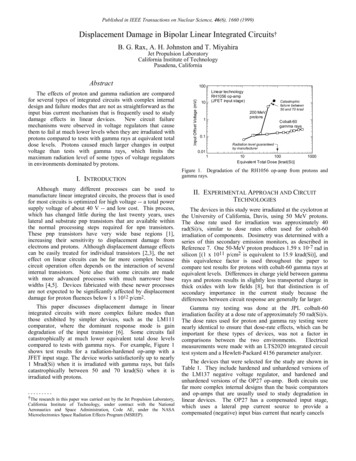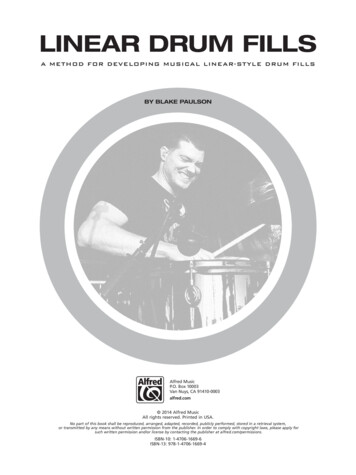
Transcription
EE6303 - LINEAR INTEGRATED CIRCUITS AND APPLICATIONSUNIT-I CIRCUIT CONFIGURATION FOR LINEAR ICs1. Mention the advantages of integrated circuits.*Miniaturization and hence increased equipment density.*Cost reduction due to batch processing.*Increased system reliability due to the elimination of soldered joints.*Improved functional performance.*Matched devices.*Increased operating speeds.*Reduction in power consumption.2. Write down the various processes used to fabricate IC’s using silicon planar technology.*Silicon wafer preparation.* Epitaxial growth*Oxidation.*Photolithography.*Diffusion.*Ion implantation.*Isolation.*Metallization.*Assembly processing and packaging.3. What is the purpose of oxidation?*SiO2 is an extremely hard protective coating and is unaffected by almost all reagents.*By selective etching of SiO2, diffusion of impurities through carefully defined windowscan be accomplished to fabricate various components.4. Why aluminium is preferred for metallization?*It is a good conductor.*it is easy to deposit aluminium films using vacuum deposition.*It makes good mechanical bonds with silicon.*It forms a low resistance contact.5. What are the popular IC packages available?Metal can package.Dual-in-line package.Ceramic flat package.6. Define an operational amplifier.An operational amplifier is a direct-coupled, high gain amplifier consisting of one or moredifferential amplifier. By properly selecting the external components, it can be used toperform a variety of mathematical operations.7. Mention the characteristics of an ideal op-amp.
* Open loop voltage gain is infinity.*Input impedance is infinity.*Output impedance is zero.*Bandwidth is infinity.*Zero offset.8. What happens when the common terminal of V and V- sources is not grounded?If the common point of the two supplies is not grounded, twice the supply voltage will getapplied and it may damage the op-amp.9. Define input offset voltage.A small voltage applied to the input terminals to make the output voltage as zero whenthe two input terminals are grounded is called input offset voltage.10. Define input offset current. State the reasons for the offset currents at the input of theop-amp.The difference between the bias currents at the input terminals of the op-amp is called asinput offset current. The input terminals conduct a small value of dc current to bias theinput transistors. Since the input transistors cannot be made identical, there exists adifference in bias currents.11. Define CMRR of an op-amp.The relative sensitivity of an op-amp to a difference signal as compared to a commonmode signal is called the common –mode rejection ratio. It is expressed in decibels.CMRR Ad/Ac12. What are the applications of current sources?Transistor current sources are widely used in analog ICs both as biasing elements and asload devices for amplifier stages.13. Justify the reasons for using current sources in integrated circuits.*superior insensitivity of circuit performance to power supply variations and temperature.*more economical than resistors in terms of die area required to provide bias currents ofsmall value.*When used as load element, the high incremental resistance of current source results inhigh voltage gain at low supply voltages.14. What is the advantage of widlar current source over constant current source?Using constant current source output current of small magnitude (microamp range) is notattainable due to the limitations in chip area. Widlar current source is useful for obtainingsmall output currents.Sensitivity of widlar current source is less compared to constantcurrent source.15. Mention the advantages of Wilson current source.*provides high output resistance.
*offers low sensitivity to transistor base currents.16. Define sensitivity.Sensitivity is defined as the percentage or fractional change in output current perpercentage or fractional change in power-supply voltage.17. What are the limitations in a temperature compensated zener-reference source?A power supply voltage of atleast 7 to 10 V is required to place the diode in thebreakdown region and that substantial noise is introduced in the circuit by theavalanching diode.18.What do you mean by a band-gap referenced biasing circuit?The biasing sources referenced to VBE has a negative temperature co-efficient and VThas a positive temperature co-efficient. Band gap reference circuit is one in which theoutput current is referenced to a composite voltage that is a weighted sum of VBE andVT so that by proper weighting, zero temperature co-efficient can be achieved.19.In practical op-amps, what is the effect of high frequency on its performance?The open-loop gain of op-amp decreases at higher frequencies due to the presence ofparasitic capacitance. The closed-loop gain increases at higher frequencies and leads toinstability.20. What is the need for frequency compensation in practical op-amps?Frequency compensation is needed when large bandwidth and lower closed loop gain isdesired. Compensating networks are used to control the phase shift and hence to improvethe stability.21.Mention the frequency compensation methods.*Dominant-pole compensation*Pole-zero compensation.22.What are the merits and demerits of Dominant-pole compensation?*Noise immunity of the system is improved.*Open-loop bandwidth is reduced.23.Define slew rate.The slew rate is defined as the maximum rate of change of output voltage caused by astep input voltage. An ideal slew rate is infinite which means that op-amp’s outputvoltage should change instantaneously in response to input step voltage.24.Why IC 741 is not used for high frequency applications?
IC741 has a low slew rate because of the predominance of capacitance present in thecircuit at higher frequencies. As frequency increases the output gets distorted due tolimited slew rate.25. What causes slew rate?There is a capacitor with-in or outside of an op-amp to prevent oscillation. It is thiscapacitor which prevents the output voltage from responding immediately to a fastchanging input.16 marks questions1.Explain in detail the fabrication of ICs using silicon planar technology.*Silicon wafer preparation.* Epitaxial growth*Oxidation.*Photolithography.*Diffusion.*Ion implantation.*Isolation.*Metallisation.*Assembly processing and packaging.2. Design an active load for an emitter-coupled pair(differential amplifier) and perform adetailed analysis to find its differential mode gain and the outputresistance.Output voltage, Vo Vcc –VBE(on) 2VA(eff) tanh(Vid / 2VT)Gain , Avd 1 / ( VT/VAN VT/VAP )Output resistance,Ro ronpn ropnp3. Design a Widlar current source and obtain the expression for output current. Alsoprove that widlar current source has better sensitivity than constant current source.For Widlar current source, VT ln( Ic1/ Ic2 ) Ic2 R2Sensitivity is defined as the percentage or fractional change in output current perpercentage or fractional change in power-supply voltage. For constant current sourcesensitivity is unity because the output current is directly proportional to supply voltage.The sensitivity of a widlar current source is better compared to constant current sourcebecause the output current has a logarithmic dependence on power supply voltage.4. Explain the supply independent biasing technique using VBE as the reference voltage.Also, find the dependence of its output current on temperature.The output current is given by, Iout VBE1 / R2 (VT /R2) ln ( Iref / Is1 ) (Circuitdiagram, self-biasing VBE reference circuit, start-up circuit to avoid zero- current state)Temperature co-efficient, TCF 9BE1/ VBE1 7 -- 5 5 75. Explain supply independent biasing using zener-referenced bias circuit. Also,design atemperature compensated zener-reference source.
The output current is given by, Iout VZ / R2 (Circuit diagram, self-biasing zener biasreference circuit, temperature compensated zener reference source )6. Obtain the frequency response of an open-loop op-amp and discuss about the methodsof frequency compensation .The open-loop gain of op-amp decreases at higher frequencies due to the presence ofparasitic capacitance. The closed-loop gain increases at higher frequencies and leadsto instability. Frequency compensation is needed when large bandwidth and lowerclosed loop gain is desired. Compensating networks are used to control the phase shiftand hence to improve the stability.Frequency compensation methods:*Dominant-pole compensation*Pole-zero compensation.UNIT II : APPLICATIONS OF OP – AMPS1. Mention some of the linear applications of op – amps :Adder, Subtractor, voltage –to- current converter, current –to- voltage converters,instrumentation amplifier, analog computation ,power amplifier, etc are some of thelinear op-amp circuits.2. Mention some of the non – linear applications of op-amps:Rectifier, peak detector, clipper, clamper, sample and hold circuit, log amplifier, anti –logamplifier, multiplier are some of the non – linear op-amp circuits.3. What are the areas of application of non-linear op- amp circuits?Industrial instrumentationCommunicationSignal processing4. What is the need for an instrumentation amplifier?In a number of industrial and consumer applications, the measurement of physicalquantities is usually done with the help of transducers. The output of transducer has to beamplified So that it can drive the indicator or display system. This function is performedby an instrumentation amplifier.5. List the features of instrumentation amplifier:High gain accuracyHigh CMRRHigh gain stability with low temperature co-efficientLow dc offsetLow output impedance6. What are the applications of V-I converter?Low voltage dc and ac voltmeterLED
Zener diode tester7. What do you mean by a precision diode?The major limitation of ordinary diode is that it cannot rectify voltages below the cut – involtage of the diode. A circuit designed by placing a diode in the feedback loop of an op– amp is called the precision diode and it is capable of rectifying input signals of theorder of millivolt.8. Write down the applications of precision diode.Half - wave rectifierFull - Wave rectifierPeak – value detectorClipperClamper9. List the applications of Log amplifiers:Analog computation may require functions such as lnx, log x, sin hx etc. These functionscan be performed by log amplifiers. Log amplifier can perform direct dB display ondigital voltmeter and spectrum analyzer. Log amplifier can be used to compress thedynamic range of a signal10. What are the limitations of the basic differentiator circuit?At high frequency, a differentiator may become unstable and break into oscillations. Theinput impedance decreases with increase in frequency , thereby making the circuitsensitive to high frequency noise.11. Write down the condition for good differentiation:For good differentiation, the time period of the input signal must be greater than or equalto Rf C1T R f C1Where, Rf is the feedback resistanceCf is the input capacitance12. What is a comparator?A comparator is a circuit which compares a signal voltage applied at one input of an opamp with a known reference voltage at the other input. It is an open loop op - amp withoutput Vsat .13. What are the applications of comparator?Zero crossing detectorsWindow detectorTime marker generatorPhase detector
14. What is a Schmitt trigger?Schmitt trigger is a regenerative comparator. It converts sinusoidal input into a squarewave output. The output of Schmitt trigger swings between upper and lower thresholdvoltages, which are the reference voltages of the input waveform.15. What is a multivibrator?Multivibrators are a group of regenerative circuits that are used extensively in timingapplications. It is a wave shaping circuit which gives symmetric or asymmetricsquareoutput. It has two states stable or quasi- stable depending on the type of multivibrator.16. What do you mean by monostable multivibrator?Monostable multivibrator is one which generates a single pulse of specified duration inresponse to each external trigger signal. It has only one stable state. Application of atrigger causes a change to the quasi-stable state. An external trigger signal generated dueto charging and discharging of the capacitor produces the transition to the original stablestate.17. What is an astable multivibrator?Astable multivibrator is a free running oscillator having two quasi-stable states. Thus,there is oscillations between these two states and no external signal are required toproduce the change in state.18. What is a bistable multivibrator?Bistable multivibrator is one that maintains a given output voltage level unless anexternal trigger is applied. Application of an external trigger signal causes a change ofstate, and this output level is maintained indefinitely until a second trigger is applied.Thus, it requires two external triggers before it returns to its initial state19. What are the requirements for producing sustained oscillations in feedback circuits?For sustained oscillations, ” The total phase shift around the loop must be zero at thedesired frequency of oscillation, fo. ie, % RU ” At fo, the magnitude of the loop gain A β should be equal to unity20. Mention any two audio frequency oscillators:RC phase shift oscillatorWein bridge oscillator21. What are the characteristics of a comparator?Speed of operationAccuracyCompatibility of the output22. What is a filter?Filter is a frequency selective circuit that passes signal of specified band of frequenciesand attenuates the signals of frequencies outside the band
23. What are the demerits of passive filters?Passive filters works well for high frequencies. But at audio frequencies, the inductorsbecome problematic, as they become large, heavy and expensive. For low frequencyapplications, more number of turns of wire must be used which in turn adds to the seriesresistance degrading inductor’s performance ie, low Q, resulting in high powerdissipation.24. What are the advantages of active filters?Active filters used op- amp as the active element and resistors and capacitors as passiveelements. ” By enclosing a capacitor in the feedback loop, inductor less active fulters canbe obtained ”Op-amp used in non – inverting configuration offers high input impedance and lowoutput impedance, thus improving the load drive capacity.25. Mention some commonly used active filters :Low pass filterHigh pass filterBand pass filterBand reject filter.16 marks questions:1. Discuss the need for an instrumentation amplifier? Give a detailed analysis for the same.In a number of industrial and consumer applications, the measurement of physicalquantities is usually done with the help of transducers. The output of transducer has to beamplified So that it can drive the indicator or display system. This function is performedby an instrumentation amplifier. Circuit diagram, instrumentation amplifier withtransducer bridge, Analysis, Expression for out put voltage.2. Explain the operation of the Schmitt trigger.Schmitt trigger is a regenerative comparator. It converts sinusoidal input into a squarewave output. The output of Schmitt trigger swings between upper and lower thresholdvoltages, which are the reference voltages of the input waveform. Circuit diagram,Analysis. Expression for upper and lower threshold voltages with and without Vref.Hysterisis width. Waveforms.3.Discuss in detail the operation of Astable multivibrator.Astable multivibrator is a free running oscillator having two quasi-stable states. Thus,there is oscillations between these two states and no external signal are required toproduce the change in state. Circuit diagram, Analysis. Expression for time period,Waveforms. Circuit for asymmetric square wave generator.4. Discuss in detail the operation of Monostable multivibrator.
Monostable multivibrator is one which generates a single pulse of specified duration inresponse to each external trigger signal. It has only one stable state. Application of atrigger causes a change to the quasi-stable state.An external trigger signal generated dueto charging and discharging of the capacitor produces the transition to the original stablestate. Circuit diagram, Analysis.5. What are the requirements for producing sustained oscillations in feedbackcircuits?Discuss any two audio frequency oscillators.For sustained oscillations, The total phase shift around the loop must be zero at the desiredfrequency of oscillation, fo. ie, % RU At fo, the magnitude of the loop gain A β shouldbe equal to unity.RC phase shift oscillator: Circuit diagram,Derive the condition for frequency ofoscillation.Gain, Av - 29Wein bridge oscillator : Circuit diagram,Derive the condition for frequency of oscillation.Gain, Av 3UNIT – 3: ANALOG MULTIPLIER AND PLL1. Mention some areas where PLL is widely used:*Radar synchronization*satellite communication systems*air borne navigational systems*FM communication systems*Computers.2. List the basic building blocks of PLL:*Phase detector/comparator*Low pass filter*Error amplifier*Voltage controlled oscillator3. What are the three stages through which PLL operates?*Free running*Capture*Locked/ tracking4. Define lock-in range of a PLL:The range of frequencies over which the PLL can maintain lock with the incomingsignal is called the lock-in range or tracking range.It is expressed as a percentage of theVCO free running frequency.5. Define capture range of PLL:
The range of frequencies over which the PLL can acquire lock with an input signal iscalled the capture range. It is expressed as a percentage of the VCO free runningfrequency.6. Define Pull-in time.The total time taken by the PLL to establish lok is called pull-in time. It depends on theinitial phase and frequency difference between the two signals as well as on the overallloop gain and loop filter characteristics.7. For perfect lock, what should be the phase relation between the incoming signal andVCO output signal?The VCO output should be 90 degrees out of phase with respect to the input signal.8. Give the classification of phase detector:*Analog phase detector*Digital phase detector9. What is a switch type phase detector?An electronic switch is opened and closed by signal coming from VCO and the inputsignal is chopped at a repetition rate determined by the VCO frequency. This type ofphase detector is called a half wave detector since the phase information for only one halfof the input signal is detected and averaged.10. What are the problems associated with switch type phase detector?*The output voltage Ve is proportional to the input signal amplitude. This isundesirable because it makes phase detector gain and loop gain dependent on the inputsignal amplitude.11. What is a voltage controlled oscillator?Voltage controlled oscillator is a free running multivibrator operating at a setfrequency called the free running frequency.This frequency can be shifted to either sideby applying a dc control voltage and the frequency deviation is proportional to the dccontrol voltage.12. On what parameters does the free running frequency of VCO depend on?*External timing resistor,RT*External timing capacitor,CT*The dc control voltage Vc.13. Give the expression for the VCO free running frequency.fo 0.25 / RT CT14. Define Voltage to Frequency conversion factor.Voltage to Frequency conversion factor is defined as,
.Y Io 9c 8fo /Vccc is the modulation voltage required to produce the frequency shift Io15. What is the purpose of having a low pass filter in PLL?*It removes the high frequency components and noise.*Controls the dynamic characteristics of the PLL such as capture range, lock-in range,band-width and transient response.*The charge on the filter capacitor gives a short- time memory to the PLL.16. Discuss the effect of having large capture range.The PLL cannot acquire a signal outside the capture range, but once captured, it will holdon till the frequency goes beyond the lock-in range. Thus , to increase the ability of lockrange,large capture range is required. But, a large capture range will make the PLL moresusceptible to noise and undesirable signal.17. Mention some typical applications of PLL: Frequency multiplication/division Frequency translation AM detection FM demodulation FSK demodulation.18. What is a compander IC? Give some examples.The term companding means compressing and expanding.In a communication system,the audio signal is compressed in the transmitter and expanded in the receiver.Examples: LM 2704- LM 2707; NE 570/571.19. What are the merits of companding?*The compression process reduces the dynamic range of the signal before it istransmitted.*Companding preserves the signal to noise ratio of the original signal and avoids nonlinear distortion of the signal when the input amplitude is large.*It also reduces buzz, bias and low level audio tones caused by mild interference.20. List the applications of OTA:OTA can be used in Programmable gain voltage amplifier sample and hold circuits Voltage controlled state variable filter Current controlled relaxation oscillator.
16 marks1. Briefly explain the block diagram of PLL and derive the expression for Lock range andcapture range.Block diagram of PLLExplanation for each block.Derivation for capture range and lock range.2. With a neat functional diagram, explain the operation of VCO. Also derive an expressionfor fo.Internal diagram for VCO IC.ExplanationDerivation for fo.3. Analyse the Gilbert’s four quadrant multiplier cell with a neat circuitDiscuss its applications.Circuit diagramAnalysisExpression for output currentApplications.4. In detail dicuss the applications of PLL:AM detectionFM demodulationFSK demodulationFrequency multiplication/division.UNIT IV – A/D AND D/CONVERTERS2 marks questions1. List the broad classification of ADCs.1. Direct type ADC.2. Integrating type ADC.2. List out the direct type ADCs.1. Flash (comparator) type converter2. Counter type converter3. Tracking or servo converter4. Successive approximation type converter3. List out some integrating type converters.1. Charge balancing ADC2. Dual slope ADCdiagram.
4. What is integrating type converter?An ADC converter that perform conversion in an indirect manner by first changing theanalog I/P signal to a linear function of time or frequency and then to a digital code isknown as integrating type A/D converter.5. Explain in brief the principle of operation of successive Approximation ADC.The circuit of successive approximation ADC consists of a successive approximationregister (SAR), to find the required value of each bit by trial & error. With the arrival ofSTART command, SAR sets the MSB bit to 1. The O/P is converted into an analog signal& it is compared with I/P signal. This O/P is low or High. This process continues until allbits are checked.6. What are the main advantages of integrating type ADCs?i. The integrating type of ADC’s doing not need a sample/Hold circuit at the input.ii. It is possible to transmit frequency even in noisy environment or in an isolated form.7. Where is the successive approximation type ADC’s used?The Successive approximation ADCs are used in applications such as data loggers &instrumentation where conversion speed is important.8. What is the main drawback of a dual-slop ADC?The dual slope ADC has long conversion time. This is the main drawback of dual slopeADC.9. State the advantages of dual slope ADC:It provides excellent noise rejection of ac signals whose periods are integral multiples ofthe integration time T.10. Define conversion time.It is defined as the total time required converting an analog signal into its digital output. Itdepends on the conversion technique used & the propagation delay of circuitcomponents. The conversion time of a successive approximation type ADC is given byT(n 1)Where T---clock period; Tc---conversion time ; n----no. of bits11. Define resolution of a data converter.The resolution of a converter is the smallest change in voltage which may be produced atthe output or input of the converter.Resolution (in volts) VFS/2n-1 1 LSB increment. The resolution of an ADC isdefined as the smallest change in analog input for a one bit change at the output.
12. Define accuracy of converter.Absolute accuracy:It is the maximum deviation between the actual converter output & the idealconverter output.Relative accuracy:It is the maximum deviation after gain & offset errors have been removed. The accuracyof a converter is also specified in form of LSB increments or % of full scale voltage.13. What is settling time?It represents the time it takes for the output to settle within a specified band ½LSB of itsfinal value following a code change at the input (usually a full scale change). It dependsupon the switching time of the logic circuitry due to internal parasitic capacitance &inductances. Settling time ranges from 100ns. 10µs depending on word length & typecircuit used.14. Explain in brief stability of a converter:The performance of converter changes with temperature age & power supply variation.So all the relevant parameters such as offset, gain, linearity error & monotonicity must bespecified over the full temperature & power supply ranges to have better stabilityperformances.15. What is meant by linearity?The linearity of an ADC/DAC is an important measure of its accuracy & tells us howclose the converter output is to its ideal transfer characteristics. The linearity error isusually expressed as a fraction of LSB increment or percentage of full-scale voltage. Agood converter exhibits a linearity error of less than ½LSB.16. What is monotonic DAC?A monotonic DAC is one whose analog output increases for an increase in digital input.17. What is multiplying DAC?A digital to analog converter which uses a varying reference voltage VR is called amultiplying DAC(MDAC). If the reference voltage of a DAC, VR is a sine wave give byV(t) Vin &RV IWThen, Vo(t) Vom&RV IW º)18. What is a sample and hold circuit? Where it is used?A sample and hold circuit is one which samples an input signal and holds on to its lastsampled value until the input is sampled again. This circuit is mainly used in digitalinterfacing, analog to digital systems, and pulse code modulation systems.
19.Define sample period and hold period.The time during which the voltage across the capacitor in sample and hold circuit is equalto the input voltage is called sample period.The time period during which the voltageacross the capacitor is held constant is called hold period.20.What is meant by delta modulation?Delta modulation is a technique capable of performing analog signal quantisation withsmaller bandwidth requirements. Here, the binary output representing the most recentsampled amplitude will be determined on the basis of previous sampled amplitude levels.16 marks1. What is integrating type converter?Explain the operation of dual slope ADC:An ADC converter that perform conversion in an indirect manner by first changing theanalog I/P signal to a linear function of time or frequency and then to a digital code is known asintegrating type A/D converter. Functional diagram of Dual slope ADC. Explanation, Derivation.2. Explain the principle of operation of successive Approximation ADC.The circuit of successive approximation ADC consists of a successive approximationregister (SAR), to find the required value of each bit by trial & error. With the arrival ofSTART command, SAR sets the MSB bit to 1. The O/P is converted into an analog signal& it is compared with I/P signal. This O/P is low or High. This process continues until allbits are checked.Functional diagram Operation Truth table, Output graph.3. Explain the operation of sample and hold circuit .Circuit diagramOperationOutput waveforms.4. Explain the various types of digital to analog converters:Weighted resistor DACR-2R ladder DACInverted R-2R ladder DACCircuit diagram & operation for each5. What is delta sigma modulation? Explain the A/D conversion using Delta modulator.Delta modulation is a technique capable of performing analog signal quantisation withsmaller bandwidth requirements. Here, the binary output representing the most recentsampled amplitude will be determined on the basis of previous sampled amplitude levels.Functional diagram, Operation.
UNIT V – SPECIAL FUNCTION ICs1. Mention some applications of 555 timer:*Oscillator*pulse generator*ramp and square wave generator*mono-shot multivibrator*burglar alarm*traffic light control.2. List the applications of 555 timer in monostable mode of operation:*missing pulse detector*Linear ramp generator*Frequency divider*Pulse width modulation.3. List the applications of 555 timer in Astable mode of operation:*FSK generator*Pulse-position modulator4. What is a voltage regulator?A voltage regulator is an electronic circuit that provides a stable dc voltageindependent of the load current, temperature, and ac line voltage variations.5. Give the classification of voltage regulators:*Series / Linear regulators*Switching regulators.6. What is a linear voltage regulator?Series or linear regulator uses a power transistor connected in series between theunregulated dc input and the load and it conducts in the linear region .The output voltageis controlled by the continous voltage drop taking place across the series pass transistor.7. What is a switching regulator?Switching regulators are those which operate the power transistor as a highfrequency on/off switch, so that the power transistor does not conduct currentcontinuously. This gives improved efficiency over series regulators.8. What are the advantages of IC voltage regulators?*low cost*high reliability*reduction in size*excellent performance9. Give some examples of monolithic IC voltage regulators:78XX series fixed output, positive voltage regulators
79XX series fixed output, negative voltage regulators723 general purpose regulators.10. What is the purpose of having input and output
linear op-amp circuits. 2. Mention some of the non – linear applications of op-amps:- Rectifier, peak detector, clipper, clamper, sample and hold circuit, log amplifier, anti –log amplifier, multiplier are some of the non – linear op-amp circuits. 3. What are the areas of application of non-linear op-
